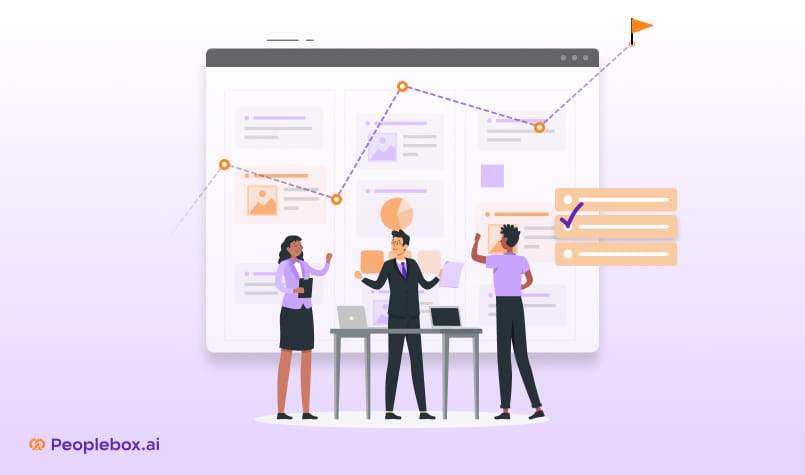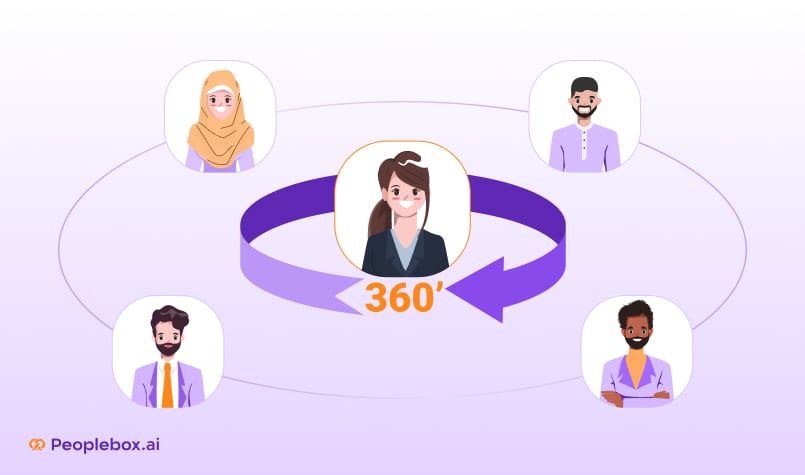Since the emergence of Software-as-a-Service and cloud computing, many companies today use the best software for each task instead of one software that does everything.
This means data for different HR tasks is on different platforms.
But for its most efficient use, you need all the data in one place.
That’s where HRIS integration comes into play.
HRIS integration stands for Human Resource Information System integration.
It means connecting an HRIS (such as BambooHR, Workday, or UKG) with other software and systems that your company uses, such as those for payroll, onboarding, and employee engagement.
HRIS integration makes sure information moves easily between your different HR applications.
Let’s look in detail why that is important.
Benefits of HRIS Integration
HRIS integration helps HR teams work better and faster. Here’s how:
1. Reduce Manual Data Entries
An effective HRIS integration allows HR departments to automate their operations by eliminating the need for manual data entry.
By automating data transfers between systems, HRIS integration removes repetitive manual tasks, improving efficiency.
2. Improve Data Quality
Besides improving efficiency and saving time, automatically syncing data across platforms improves data consistency and quality.
It reduces the chances of human errors and makes sure your HRIS has the most up-to-date information.
This is a huge benefit because bad data can be very costly, with the U.S. losing around $3.1 trillion yearly due to it.
3. Prevent Data Silos
This prevents data silos by creating a single data environment where information flows easily across different functions.
By connecting an HRIS with other important systems like payroll, benefits administration, and performance management, all your HR data is gathered in a single, accessible location.
As Aaron Green from SAP SuccessFactors explains:
“The role that HR serves within organisations has changed in recent years, and it has to change. HR leaders are now commonly seen as key contributors in shaping the strategy of the business.
But in order to do that, they need to have a really clear view of their entire workforce.”
With HRIS integration, HR leaders can get that clear view, helping them make better decisions and support the company’s goals.
4. Better Analytics and Reporting
A part of what helps HRs make better decisions because of interconnected data is better people analytics and reporting.
Integrated data allows platforms to provide much better insights, patterns, and trends. This helps HR professionals make smarter choices.
5. Gives a Competitive Edge
Ultimately, HRIS integration is about creating a more agile and responsive HR function that supports the broader organisational goals.
High-composability enterprises, which effectively integrate their systems, expect an average revenue growth of 7.7%, compared to 3.4% for low-composability enterprises.
Now that you understand the key benefits of HRIS integration, let’s look at some of its popular use cases.
Use Cases and Workflows
HRIS integration can be used for many HR processes, from recruitment and payroll to compliance and employee management.
The table below shows workflows for some common use cases, detailing which action triggers what sequence of events. You can also see examples of software that needs to connect with your HRIS for each use case.
| # | Category | Use Case | Workflow | Example Software |
| 1 | Performance Management | Manage performance reviews | Peoplebox connects with HRIS. Performance review period starts -> Managers/employees complete evaluations via Peoplebox’s Slack/Teams integrations -> Performance data synced with HRIS -> HRIS stores records for reporting. | Peoplebox |
| 2 | Payroll | Automate payroll processing | ADP integrated with HRIS. Employee hours logged into HRIS -> HRIS sends time data to ADP -> ADP processes payroll -> Payroll data updated in HRIS. | ADP, Paychex, Gusto |
| 3 | Time and Attendance | Manage employee shifts and attendance | Clockify integrated with HRIS. Employees clock in/out using Clockify -> Clockify sends data to HRIS -> HRIS updates records -> Managers review and approve project hours in HRIS. | Quickbooks Time, Clockify, Timetastic |
| 4 | Benefits Administration | Streamline open enrollment | Benefitfocus connected with HRIS. Open enrollment starts -> Employees select benefits in Benefitfocus -> Selections updated in HRIS -> HRIS generates payroll deduction reports. | Benefitfocus, Employee Navigator |
| 5 | Applicant Tracking | Manage recruitment process | Greenhouse integrated with HRIS. Candidate hired -> Greenhouse sends data to HRIS -> New employee records created in HRIS -> HRIS triggers onboarding processes. | Greenhouse, Lever |
| 6 | Learning Management | Track training and certifications | Cornerstone OnDemand integrated with HRIS. Employee assigned training -> HRIS sends assignment to Cornerstone -> Employee completes training -> Status updated in HRIS -> HRIS updates training records. | Cornerstone OnDemand, Moodle |
| 7 | Employee Self-Service | Provide self-service access | Oracle PeopleSoft connected with HRIS. Employee logs into ESS portal -> Updates personal info or submits leave request -> Changes reflected in HRIS -> HRIS notifies relevant departments. | Oracle PeopleSoft, InStaff |
| 8 | Onboarding | Automate onboarding process | WorkBright integrated with HRIS. New hire accepts offer -> HRIS sends data to WorkBright -> WorkBright starts onboarding tasks -> Completed documents synced back to HRIS. | GoCo, WorkBright |
| 9 | Expense Management | Manage expenses | SAP Concur connected with HRIS. Employee submits expense report -> Concur processes and sends approved expenses to HRIS -> HRIS updates payroll -> Reimbursements issued during next payroll cycle. | SAP Concur, Expensify, Zoho Expense |
| 10 | Compensation Management | Manage compensation | PayScale integrated with HRIS. Annual review period -> PayScale provides salary data -> HRIS updates compensation plans -> Updated info used for payroll and records. | PayScale, CompTrak, Salary.com |
Next, we’ll examine the various ways you can integrate your HRIS with different softwares to achieve these use cases.
Integration Options
There are 4 main ways HRIS systems can be integrated with other HR applications:
- Point-to-point or custom integration
- Out-of-the-box or native connectors provided by the HRIS
- Unified APIs
- Integration-platform-as-a-service (iPaaS)
Let’s look at each, what they are best suited for, examples, and pros and cons:
| Point-to-Point / Custom Integration | Out-of-the-Box / Native Connectors | Unified APIs | Integration-Platform-as-a-Service (iPaaS) | |
| Description | Direct connection between two specific systems, custom-made for specific needs. | Pre-built connectors by the HRIS vendor to integrate with common apps and systems. | APIs that give a simple way to connect to many services or systems. | Cloud-based platforms that help connect various apps and services with built-in tools. |
| Best For | Highly specific and tailored integrations | Quick and supported integrations with common systems | Simplifying complex multi-system integrations | Scalable and easy-to-manage integration solutions |
| Examples | Direct API calls, custom scripts | Built-in connectors for payroll, ATS, LMS within HRIS | Apideck, Merge, Finch, Bindbee | Workato, Jitterbit |
| Pros | Tailored to business needs, control over specifics, valuable for unique use cases | Quick to set up, supported by HRIS vendor, lower initial cost | Makes integration easy, consistent API interface | Scalable, user-friendly, includes tools for monitoring and management |
| Cons | Complex to build and maintain, not scalable, breaksdown as more and more apps needto be connected | Limited flexibility, may not cover all use cases | May not support all features, dependent on third-party API provider | Can be costly, dependent on platform’s capabilities and reliability |
While each integration option has its own positives and negatives, there are some general challenges for HRIS integration that you need to be aware of so you know what to expect.
Challenges
While HRIS integration is important to make the best use of your HR apps and data, some challenges can stop companies from fully connecting their HR systems.
Here are some key challenges you might face and how to handle them.
1. Cost
The biggest challenge for HR teams thinking about integration is cost. About 57% say it is their main problem.
The cost may include:
- Initial setup: Costs like software fees, licensing fees, APIs or iPaaS platforms, and salary for special IT help and consultants.
- Custom development: Customising the HRIS to meet your specific business needs.
- Data mapping and transformation tools: Matching and converting data to consistent format
- User training: Training employees to use the new HRIS, which may involve training sessions, workshops, and creating training materials.
- Ongoing maintenance: Regular system maintenance, updates, and upgrades to keep the HRIS working well
“While cost is always a factor, organisations should view HR systems integration as an investment that will actually save them both time and money in the long run.
Cumbersome and antiquated processes such as data entry can lead to lost productivity and low morale, both of which can become extremely costly in their own right,” writes i-PaaS platform Jitterbit in their study.
2. Security and Data Privacy
After cost, the second biggest challenge for HRs considering integrations is security and data privacy, at 44%.
Integrating different systems often means moving sensitive employee information, which can increase the risk of data breaches.
Data breaches can cause financial and reputation damage, so companies must work closely with legal and IT teams to meet all data privacy rules (like GDPR in Europe or CCPA in California) when integrating HRIS.
3. Data Standardisation
Another big challenge in HRIS integration is data standardisation. It means making sure all data is consistent and follows the same format.
Different systems might store data differently, causing problems. For example:
- One system might use MM/DD/YYYY for dates while another uses DD/MM/YYYY.
- One system might list a job title as “Software Engineer” while another lists it as “Software Eng.”
- Department names could be “Human Resources” in one system and “HR” in another.
Mismatched data can lead to loss or duplication, leading to issues in reporting and analytics.
To solve this, it’s important to set uniform data standards across all systems.
Using data mapping and data transformation tools can help automate this process and reduce errors. Data mapping defines how data from one system matches data in another, while transformation tools convert data into a consistent format.
4. Data Synchronisation
Besides data standardisation, another challenge during HRIS integration includes making sure data is accurately and consistently synchronised between systems.
Post integration, inconsistent data updates can cause outdated or missing information if one system doesn’t reflect changes made in another.
Using strong integration and automation tools can help solve these problems.
5. System Compatibility
Just like data formats need to match, systems also need to be compatible.
Legacy systems often can’t easily connect with newer HRIS solutions because they don’t have modern APIs. For example, an old payroll system might not support the new ways of sharing data, making integration hard.
Moreover, different systems might use different API standards, causing hurdles in integration.
Using different integration options like middleware or iPaaS can help standardise these interactions and make sure data can move smoothly between systems.
6. System Downtime and Disruption
Finally, system downtime during HRIS integration can hurt business operations. Important HR functions like payroll, employee self-service, and hiring can be disrupted.
To reduce this risk:
- Create a detailed plan with backup measures
- Use a phased approach to move different HR functions gradually
- Keep employees and stakeholders informed about the timeline and any impacts
Now that you understand the potential obstacles and how to handle them, let’s turn our attention to how you can successfully integrate your HRIS with your other systems.
Steps for Successful HRIS Integration
A successful HRIS integration involves several steps. Let’s look at each of them in detail:
1. Initial Planning and Needs Assessment
Initial planning and needs assessment are a must for successful HRIS integration. In this phase, you would:
- Define Objectives: Decide what you want to achieve, like better efficiency or data management.
- Involve Stakeholders: Include key people from HR, IT, and management to address their needs.
- Allocate Resources: Figure out the budget, time, and staff needed.
- Assess Risk: Identify risks and plan how to handle them.
2. Choose the right HRIS software
Choosing the right HRIS software is the next important step in ensuring successful integration.
In fact, companies spend an average of 15 weeks selecting the HRIS software.
It involves the following steps:
- Compatibility Evaluation: Assess the compatibility of the new HRIS with existing systems and applications.
- Vendor Evaluation: Consider vendors with a proven track record in successful integrations and strong customer support.
- Feature Analysis: Ensure the HRIS includes all necessary features to meet your organisation’s requirements.
3. Create an Integration Plan
Creating a detailed integration plan is essential for successful HRIS implementation.
Here’s what to focus on:
- Project Timeline: Make a timeline with milestones and deadlines.
- Task Assignment: Assign specific tasks to team members.
- Communication Plan: Plan for regular updates and communication among stakeholders.
- Contingency Plans: Prepare backup plans for potential setbacks.
4. Data Sharing and Quality Assurance
Connecting data to a new HRIS can be tricky.
To avoid problems, follow the steps below:
- Data Audit: Check existing data for inconsistencies, duplicates, and inaccuracies.
- Data Cleaning: Ensure data is accurate and complete.
- Data Mapping: Match data fields from the old system to the new HRIS for proper sharing.
- Testing: Test thoroughly to ensure data integrity and functionality.
5. Integration and Customisation
Finally, follow these steps to integrate your HRIS with other systems:
- Integration: Use built-in or custom APIs, or any other method discussed above, based on your unique needs, to connect the HRIS with other systems and ensure smooth data flow.
- Customisation: Customise the HRIS to match your company’s workflows, policies, and procedures, making it more effective.
6. Compliance check
As part of the integration, it’s important to make sure the data is safe.
Here are the steps:
- Review Security Features: Check the HRIS’s security, data handling, and privacy policies.
- Work with Experts: Get help from legal and compliance experts to find and fix any issues.
- Regular Audits and Training: Do regular system checks and train employees on data protection to keep everything up-to-date and compliant.
7. Training and Support
Now that you have successfully completed HRIS integration, it is important to make sure everyone knows how to use the new system effectively.
Here’s how to do it:
- Training Programs: Create training programs to teach everyone how to use the new system.
- Support Systems: Set up help desks and super-users to assist employees during the transition.
- Communication of Benefits: Explain the benefits of the new system to encourage everyone to use it.
Conclusion
In conclusion, HRIS integration transforms HR operations by unifying data and processes. It will save you time, make you more agile, and improve your decision-making.
This handbook covered everything you need to know, including different use cases, integration options, challenges, and step-by-step instructions.
Ready to optimise your HR operations? Start your HRIS integration journey today and see the benefits for yourself.







